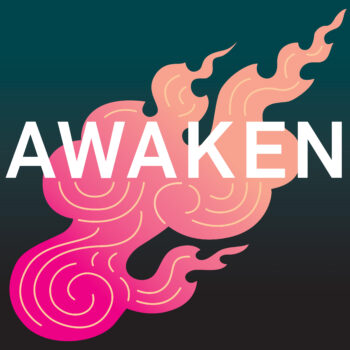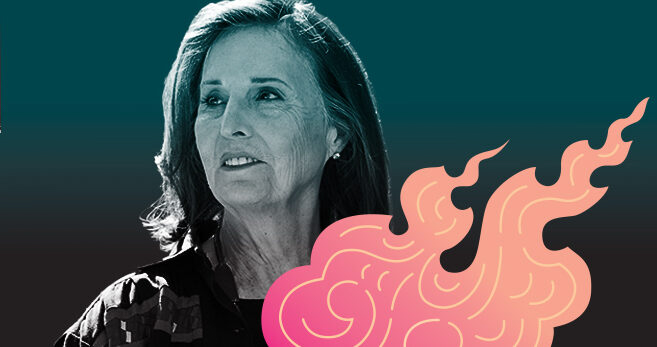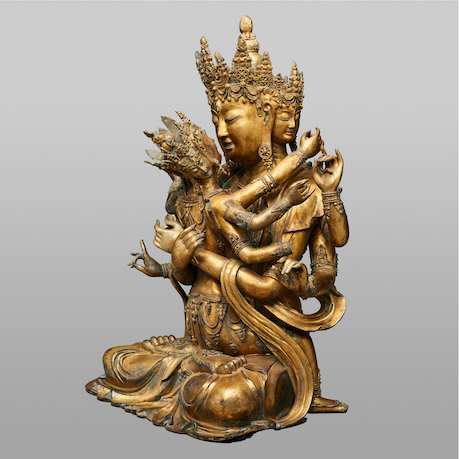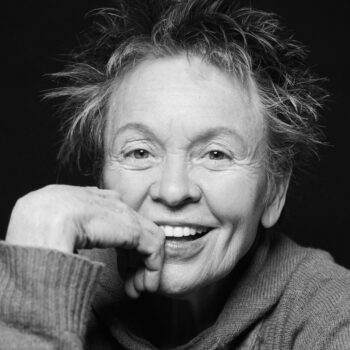

Remarkable experiences can inspire, but without integration, they can also bring a sense of alienation. What role does integration play in the process of awakening? In this episode, we speak with Patricia James, a Medicine Woman of Seminole tribe heritage who has been formally trained in the Cheyenne tradition as a Priest and a Pipe Carrier, which means that she is a steward of a sacred pipe and the religious ceremonies for which it is used.
PATRICIA JAMES:
My first Native American church meeting, one of the older medicine men came up to me and said, “If you can’t bring back what you experience and incorporate it into your life, you’re being a dilettante.” It’s the integration that really is where all the work is.
LAURIE ANDERSON:
Welcome to AWAKEN, a podcast presented by the Rubin Museum of Art in New York City. That was the voice of Patricia James, and I am your host, Laurie Anderson. In this 10-part series, we explore the dynamic path to enlightenment and what it means to wake up. We’ll hear from authors, artists, wisdom bearers, and Buddhist teachers, people who have experienced a shift in their perspectives on life throughout their personal journey. This podcast is inspired by the exhibition Awaken: A Tibetan Buddhist Journey Toward Enlightenment, which illustrates the stages of enlightenment through paintings, sculptures, and other objects. We use these artworks as a jumping off point to better understand the paths our guests have been on and where they are going.
In this episode, we dive into the idea that all things are interconnected. We speak with Patricia James, a medicine woman of Seminole heritage. As an adult, she was adopted into the Cheyenne tradition and formally trained as a priest and pipe carrier. Before Patricia shares her journey of how she came to be a medicine woman and how she developed her relationship with the divine, she first responds to a sculpture of a pair of intertwined lovers, Guhyasamaja and Sparshavajra, joined in sexual union. These figures represent masculine and feminine energies or compassion and wisdom, which in the Tibetan Buddhist tradition unify to elevate consciousness toward awakening.
PATRICIA JAMES:
What I see is a merging of male, female””magnetic, dynamic energies and forces that integrate and become balanced. And it actually is quite representative of a concept I teach and do my best to live by. And it’s related to our ancestors. And those are the spirits of the people who’ve gone before us who are there to help us, because they want the next seven generations to fare well and find their life purpose. And the way this relates is, when we can merge our dynamic or our male energy that we put forward to the world with our magnetic, the qualities of the feminine or the masculine.
But if we can get away from gender to magnetic, which is the energy that draws inward, with the dynamic, which are energies that go out and forward and present, and weave them through our heart, which is where integration takes place, then we have a balanced whole. This statue looks like that’s occurring, where the energies are being merged into something that is balanced.
That reflects the way I teach. Often a concept called the braided way. And the braided way comes from an indigenous prophecy. When the wisdom of the sky and the wisdom of the earth are graded through the human heart, then there will be a rainbow of people. And the concept of that””the dynamic or the magnetic””is that when we can hold a vision of the braided way, it’s a symbol for unifying polarities of any kind and creating an original third option. And ultimately, from that, we get this third option, but within the tension of this crucible, we create safety. We have to have safety to heal. And so the integration can come forward or the blending of the wisdom and the compassion, which are so important to humanity right now.
All the elders that I speak with from all the traditions say the same thing””that we are out of balance. That we have lost our connection to nature. And that until we connect once again with the nature, which is our nature, we are in trouble as a human species. And the way one tribe explained it to me was, “We can’t live without you, and we can’t live with you, and you can’t live without us, and you can’t live with us.”
And so I was essentially directed and encouraged and told to go forward and teach this. And I’m not a savior. I’m just another individual with some teaching that might help. Many traditions are passed on orally. They are oral traditions. So part of it is to pass those along. Another aspect is that this knowledge may go away. I believe without context, we lose sometimes the whole point or a message, but we lose an important piece of our integration so that each of us can grow as individuals and also become good community members. It’s important that we move from the “I: to the “we” at this point in time, because we’re out of balance. We’re out of balance often as individuals, as a culture, we need to take care of our earth or a mother that supports us. And we are facing climate change. We’re facing, we’re just emerging from a pandemic. These are things that we can only solve and resolve together, in community. And it’s important that we are healthy individuals so that we can become healthy community members.
I think the pandemic is a great mirror for us as individuals and as humanity. It’s been good to slow down. It’s important for us all to take time, to be quiet and be still. I think there’s an aspect of mortality that has come to the forefront for us as a culture. I believe it’s shown how as individuals, we need to be responsible for the collective as well, and that we need to take care of ourselves and take care of others. That interconnectedness, it’s shown us there are really no boundaries.
Well, I come from a military family, so I moved around a lot. To my good fortune, I got to live on islands and in beautiful places. So I spent time in Hawaii and in the Pacific Northwest. And I was primarily out in nature. So I’ve always been in nature, lived in nature. Nature was my solace, my place where I would go. I would often have experiences of being one with things, like when I was little, I thought I could talk to trees. And then later I was told, no, you can’t talk to trees. But I had a deep, deep connection particularly to water and how to swim with it, how to body surf, how to find that flow.
The outdoors was my church. That’s where I went to figure things out””my place I went to find answers or to heal, to feel that warm embrace. I really valued the concept of ceremony and that there was a God. But as I grew older, especially getting towards high school, I began to wonder how come my friends who are not Catholic couldn’t go to heaven with me. So I took a pretty traditional turn, and I became an agnostic. I couldn’t remain an agnostic because of my experiences in nature and my connection to nature. So I began to believe that there was a greater force than me or my concepts of God as I knew them, but just the magnificence of life. Some intelligence had to be behind that.
I also was a very good athlete. So there were times I would have out of body experiences or non-ordinary experiences that we used to call flow or height, you know, peak performance. We can’t be in a peak state or a flow state with thinking. And the West is very mental. And so one example is downhill skiing. There’s a moment when you can’t sync and ski down a mogul field; you have to be in that moment. But then there’s a moment where you also know that the mountain is skiing you and you are skiing mountain. And then how to perform and stay in that place, that’s a peak performance. I’ve had it protect me. I was kayaking once and turned over in rapids. I could see myself go out of my body, and I was shown how to navigate through all the rocks and the rapids so that I wouldn’t hurt myself and protect myself.
I might say one other that gets back to the interconnectedness. I was swimming with dolphins at Kealakekua Bay decades ago with a friend. The way I would call in the dolphins would be to sing prayer songs or sing songs to them. And this time there was just this huge school of dolphins. And I dove in and I could see this light coming from the bottom and big rays. And the dolphins were all swimming around and coming really close, but they were swimming face to face in a sense, mirror to mirror. And I’d never seen that. And so they were swimming in pairs and I could hear them singing. And so I just relaxed and went into the songs or what I was hearing. And I was curious about this mirroring swimming. And I thought to myself, what are you doing? What is that? And this pair of dolphins swam up to me, looked me in the eye. And I heard, “If we are of great spirit, so are you.”
I got married and had a professional career and life was going along as it seemed like it should. And then at about mid-early forties, everything went upside down. I saw my parents’ relationship disintegrating. I could tell my relationship was going to end. I had to reestablish myself professionally, and I’m the oldest of eight children. My youngest brother had an accident where he broke his neck and became a quadriplegic, which had a devastating effect on the family. And it really brought me to kind of question the magnitude of such an accident and how to reshape a life and the effects that has on everybody, the community, the infrastructure.
In retrospect now, I was going through multiple grieving cycles. Before I could even finish one, another would start, but the point is, I had no tools to figure out how to act, and be, and go forward. A friend suggested I go to this workshop that I might enjoy. It had been full. All of a sudden it opened up, I was able to get in. It was a week-long workshop with Angeles Arrien. And as it turns out, she was teaching a new module and way of taking her knowledge and putting it together. And so, as it turns out, all her friends decided to come to this particular workshop and support her. And in the room, I knew a few people. Schultz was there, who was one of the founders of group dynamics, but essentially every person involved in moving the transpersonal world forward was in that room or many of them. And in retrospect, what I know now is I met my future in that room.
Angeles, her work became a pillar in my practices, and a very important concept that Angeles put forward that stuck for me was: it’s important to know where we come from. It’s important for us to know our roots. So I came away wanting to study more and learn more about my Native American roots. I’m part Seminole. And essentially this path opened to me, that I had no idea existed, but I was soon learning how to do sweat lodges. I was brought in by Native people to teach, and to mentor, and to learn. But essentially I ended up in a Native American church meeting, a peyote meeting, about a month later. And I found my heart. It was the most magnificent, beautiful ceremony. And most importantly, it was the first time I learned how to pray.
Physically I felt that I was one with everything. It was almost as though my body was very permeable; that I was a part of the air, that I was a part of the fire, that I was a part of the earth I was sitting upon. That I was a part of the water, that I was a part of all the hearts there. But most importantly, I was a part of the greatest heart, the big heart of the universe, and that there was just no separation. I was touching God. I was touching the unknown. I was touching something that I had access to all the time. Once I opened my heart, there was no barrier between that and me and my heart, and that I was a part of it. And so it sort of sent me along. I was really curious about knowing what were the practices? What were the ways of being that worked well? How do we live life well? And so that was what I set about to learn and understand.
From there I began to spend more time learning around these ways. I would spend more time in ceremonies, sweat lodges, learning how to build sweat lodges. I had incredible teachers, and I realized that this was really how I could grow. And so this went on for years, and then I was met by my grandfather, Eugene Black Bear Senior. He’s from the Cheyenne tribe, pure blood Cheyenne, who was interested in seeing how well I was holding these ways to this point. And he asked if I wanted to come back to Bear Butte, South Dakota, and support a fast. I never worked so hard in my life. And it’s a very, very complex, intense, structured process, which is true of most everything I’ve learned. Where it’s skill development, it’s a deepening in the heart and the practices. There were requirements, let’s say, of having to put a hundred songs to memory, a hundred prayers, a hundred practices of stories. And so it went for years and years and years, and we’re being trained to have comfort in both the seen and the unseen world, where there’s no separation. Again, that integration where we can be present in the moment and that there’s no separation between the spiritual and the practical.
A medicine woman is a way of life. It’s a way of balance. It’s a way of prayer. It’s a way of presence to help hearts heal, and souls heal, and to help everyone, each individual, find that inner healer and wisdom within themselves, so that they can be happy and joyful and live a good life and grow into a good human being.
I look for openings and people so that I can draw them to their fullness and expression as a human. And I heard elders described once as those who grow human beings. And when the Europeans and others came to the Americas and south-north continent, the indigenous and people that they encountered, they asked them, who are they? And all of them identified as humans, human beings. A medicine woman helps people identify and grow themselves into the human being that they were sent here to be and bring forth their gifts and talents.
I would not use that title unless I had been told to identify that way. So I was told to identify that way. I didn’t decide to call myself that. And so that’s a very traditional piece. A lot of individuals these days are calling themselves medicine people, by just declaring it, because they want a title as they enter into the particularly psychedelic space.
I’m an enrolled member of the Native American church. And because of the Religious Freedom Act, we are, in ceremony, allowed the use of a plant medicine, a sacred plant medicine. My religious practices at times include peyote. Other sacred plants come from different regions in the world and are held by cultures that surround them and society even incorporates around them. And there’s ways of being with those plants and the power of their healing properties that is in harmony with the lands. And so there’s integration that takes place in the community, within the ceremonies, and within this concept of the sacred and the divine, and that there are tools that keep the well-being of the tribe, the community, the culture, intact, healthy, and growing.
Everything in indigenous cultures boils down to relationships, our relationship with ourselves, our relationship with the environment, our relationship with others, and our relationship with the information that comes from these plant medicines. And that there’s many things that can come from that relationship. But we must remember it’s a total relationship and ask ourselves, am I in right relations? In many ways, it’s not different from a flow state, or a non-ordinary state of consciousness. Human beings are wired neurologically and desire what we call non-ordinary states of consciousness. Traditional cultures might call them ordinary states of consciousness. And as I spoke about earlier, for me, it came early in the forums of a flow state, a state of unity.
And so cultures go through vision quests, or some form of deprivation””no food, no water alone in the wilderness””to get a message, to have that time, to hear that inner voice. Breathwork, holotropic breathwork, ways of breathing can get us into an altered state or a non-ordinary state. Spinning can do it, dancing, long chants of singing can do it. It allows us to get into the moment into the presence. And so that’s also a thread throughout all wisdom traditions and culture””that be here now. What can quiet us and get us into the present moment? Ultimately, where we can work in both the seen and the unseen. Where we feel unity with all things. It’s where the seed of choice comes from. We can choose to be more kind. We can choose to extend more love. We can choose to live in integrity. We can choose to take right action. We can choose to be present. We can choose to not be present. It’s really a seat of power.
My first Native American church meeting, one of the older medicine men came up to me and said, “If you can’t bring back what you experience and incorporate it into your life, you’re being a dilettante.” It’s the integration that really is where all the work is. It’s a process of meaning making. In a sense, I describe it as bringing the practical to the mystical, because we live in a world where we have to be practical, but how can we include the mystical in that? And there’s certain ways of beginning to anchor it. And then there’s ways of really cultivating it and developing it. Well, there’s some practices with integration that can be helpful. Capturing what we often call the kernel or the seed is important and can be done by writing a haiku for instance. Or titling the experience like a book title or a movie title. Or trying a symbol, because it helps anchor that experience, the unknown of it, and it’s a way for the psyche to connect again. It takes some time. And it helps to have a coach or a mentor guide. And then when you add practices, for instance, the meditation, the prayer, the outside, being outside nature, having a community to work with, then we have meaning. We have change.
Without integration, there’s sometimes an untethering from reality or that as we know it. There’s a confusion. There’s a retraction. Without integration, sometimes people will try another experience and layer another experience after another experience. And that’s detrimental to one’s well-being because there’s a fracturing of our essence. Some people can’t even, may not be able to do just very practical things like making their bed, showing up at work, and doing their work. It’s very disorienting.
I believe that integration teaches us how to live and be whole and complete and in unity with all things and all beings, and ultimately the great spirit, the divine. Awakening probably has again, at least for me, has been an unfolding and developmental. But the most important thing is it’s something that touches us, opens our heart, but changes us in a profound way that we can never go back to how we were. And one way might be a bit, it gives us a sense of the, “There, there, oh! This is a taste of the divine. This is a taste of awakening.” So then we have something to grow into. The prophecies talk about, if we don’t use the insights that are given to us, and actually this comes from working with the ancestors, they want to see that the information that they’ve shared is helpful and that they listen””we listen. And if we don’t, then they go away. It’s a partnership.
I think it’s important to consider how best we can support the traditional and indigenous peoples in this time of great crisis of health. The virus is running rampant, the traditional and native and indigenous peoples throughout the world are in very dire times. And the healthcare system is very broken, but there also hasn’t been support for their traditional health healing. And so I think this is a time of important reciprocity to give to these people of the world who’ve held these sacred ways. Whatever help they would want””be it financial, be it medical, be it protection, where we don’t go to them, seeking a ceremony at a time when they need to make sure they’re healthy again. So how can we take care of what has taken care of us? And it’s so important to ask them, really considering the concept of reciprocity, because many of these people of the lands are losing their lands. And that means they’re losing their herbs and their plants and their sacred places. How do we help restore that? How do we protect that? How do we bring in that braided way?
LAURIE ANDERSON:
Before we come to a close, Patricia is generous enough to share with us a meditation practice that helps connect us to our ancestors.
PATRICIA JAMES:
So I invite everyone into a meditation in a traditional way of bringing in our ancestors and asking for assistance. So today, if you would, get your feet on the ground or on the floor. Make sure that all four quadrants of your foot are touching the earth. And I’d like you to just take a few deep breaths. And if you would take your right hand and place it over your left hand and place both hands over your heart, and take some deep breaths, and feel the earth under our feet, and bring your breath into your heart. And as you breathe, I would like you to think about synchronizing your heartbeat with your breath. And breathe into your heart and synchronize and take a moment until your heart begins to breathe. You breathe into your heart until your heart begins to breathe you.
And I’d like you to think about something that you’re wanting to grow into. Something you’d like insight into, some purpose in front of you that you want to fulfill. And think about those in your family, your bloodline, or people who’ve inspired you, but who have shown us the ultimate practice of letting go by dropping their skin. So these are individuals that have passed on. And place on your left side, your magnetic side, those individuals that have the qualities of the feminine that you wish to bring in. And line them up behind your left side, where you might want to be cultivating more courage, more intuition, more empathy, more patience, more tenacity. On the right we’ll bring in our ancestors with the qualities of the masculine, those dynamic qualities””action, robust forward movement, whatever that quality is.
And so for me, on my left is Angeles Arrien and my dear mentor and friend. And on the right is my grandfather, Eugene Black Bear Senior. Both of these people have helped bring me to this moment. And take the qualities that you’ve identified or those individuals and weave them into your heart. And bring in the teachings of the heart, our dynamic and our magnetic ancestral qualities we want to weave. And who was your first great teacher of the heart? And bring them in. And let’s breathe again, all those qualities, all those memories, those individuals breathe . . . and breathe that awareness, that integration into our feet.
And let’s take a breath again and let’s breathe in peace. Peace into ourselves, peace into our communities, peace into the qualities we’re bringing forward and we’re asking for support with. And now let’s breathe in love. Fill that heart so that we can go full-hearted into the day and into the project. But most importantly, how can we go into our lives with this kind of support and presence and being. So for a few moments, just breathe into your heart, let the heart breathe you. Remember, at any time, anywhere we can do this. We can breathe into our hearts. We can ask for help from our allies. And we can become present in the moment, from a place of integration and heart, to the very best we can be at this moment.
LAURIE ANDERSON:
Thank you so much to Patricia James for sharing her experience with us. We hope you enjoyed it. For more information about our guest and to see images of the artwork in this episode, visit Rubin Museum.org/awakenpod. If you’re hungry to continue the conversation, join us on Instagram @RubinMuseum. And if you’re enjoying this podcast, leave us a review wherever you listen to podcasts. Leaving us a review is one of the best ways to help this podcast reach more listeners like you.
AWAKEN is produced by the Rubin Museum of Art in collaboration with Sound Made Public, and I’m your host, Laurie Anderson. This podcast is supported by Barbara Bowman, the Ellen Bayard Wieden Foundation, the Prospect Hill Foundation, Bob and Lois Baylis and public funds from the New York City Department of Cultural Affairs in partnership with the City Council. Awaken is sponsored by Tricycle: the Buddhist Review, a print and digital magazine dedicated to making Buddhist teachings broadly available. Music for AWAKEN was created by Blue Dot Sessions, Podington Bear, Tendinite, and Siddhartha Corthus.
Join in next time for our last episode of the season of AWAKEN. It’s a very special one.
To begin, Patricia considers a sculpture of an intertwined pair of lovers, Guhyasamaja and Sparshavajra, which represent the concept of nonduality, the idea that everything is interconnected. This artwork represents the union of apparently opposing forces often expressed in Tibetan Buddhist art as a sexual union of male and female, or compassion and wisdom, the combination of which are necessary for elevating consciousness toward awakening. Read more about the episode’s guests below.

Guhyasamaja and Sparshavajra; Beijing, China; Ming dynasty, ca. 1400″“1500; Gilded bronze; Asian Art Museum of San Francisco; The Avery Brundage Collection, B64B23
Guhyasamaja means Secret Union, indicating the joining of apparent opposites, including male and female like these figures, as well as the wisdom and techniques that lead to Vajrayana Buddhism’s swift awakening. Both figures have six hands, and the implements they originally held were matched, each associated with one of the Five Cosmic Buddhas. Accordingly, this life-sized sculpted pair constitutes an embodied mandala.
Created in China during the period of the Ming dynasty, this image was likely made either as a gift to an important Tibetan lama or for use in a Vajrayana temple in China.

Patricia James is a Medicine Woman of Seminole heritage who was adopted and traditionally trained as a Cheyenne Pipe Carrier and Cheyenne Priest. She is a cross-cultural expert whose work is informed by the mentorship of Basque cross-cultural anthropologist, Angeles Arrien, Cheyenne Grandfather, Eugene Blackbear, Sr., and her work with the elders of multiple psycho-spiritual modalities.
She is a teacher, mentor, and consultant for the California Institute of Integral Studies (CIIS) certificate program in Psychedelic Therapy and Research (CPTR). She maintains a private practice in the San Francisco Bay Area that focuses on psycho-spiritual mentoring, integration, teaching, speaking, group and individual workshops. She also provides ritual-based ceremonies.

Laurie Anderson is one of America’s most renowned and daring creative pioneers. She is best known for her multimedia presentations and innovative use of technology. As writer, director, visual artist, and vocalist she has created groundbreaking works that span the worlds of art, theater, and experimental music. Ms. Anderson has published seven books, and her visual work has been presented in major museums around the world. In 2002 she was appointed the first artist-in-residence of NASA, which culminated in her 2004 touring solo performance The End of the Moon. Her film Heart of a Dog was chosen as an official selection of the 2015 Venice and Toronto Film Festivals and received a special screening at the Rubin Museum, where she joined in conversation with Darren Aronofsky. Ms. Anderson has made many appearances at the Rubin, and has been in conversation with Wim Wenders, Mark Morris, Janna Levin, Gavin Schmidt, Neil Gaiman, and Tiokasin Ghosthorse. She also hosted the premiere season of the Rubin’s AWAKEN podcast.
Get the latest news and stories from the Rubin, plus occasional information on how to support our work.